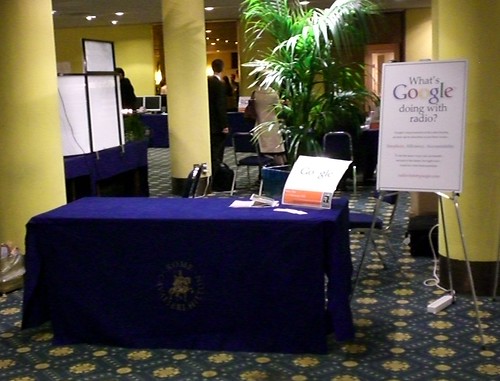Google’s exit from the radio arena this week wasn’t necessarily a huge surprise. It was a bold move to try and port their successful advertising business from the Internet to radio, and to do so without primary control over the inventory they were selling and the environment they were selling into. But it didn’t seem to be getting the prominence in the marketplace to make it successful.
Google created a relatively rich technology ecosystem in order to support the on-line trading of radio airtime. They acquired dMarc, and set about re-branding and reworking that company’s playout system, to relaunch it as Google Automation, with integral support for Google’s APIs for advert insertion. They worked with the vendors of other major playout systems to extend the number of playout products supporting Google ad insertion. They created a pretty good, simple, on-line interface to allow people to book airtime campaigns, and monitor the performance of them. And the Google Creative Marketplace allowed advertisers to find creatives to make their radio adverts.
There are some things that I don’t think we’ll really miss. I was really disappointed with the Google Automation product, which I didn’t think was worthy of having the Google brand applied to it. When I think of Google, I think of innovative UI design, clever APIs, and rich-meta data. Google Automation didn’t live up to those expectations, and I think there are much more capable and exciting playout products in the market.
Google tried to sell radio advertising as a commodity; buyers didn’t know what stations their ads were going to run on, and they only had vague controls over formats, demographics and geographic area. That Google was unable to commoditise radio is probably good news. It means that brand values, production values and market prominence are still important, and that advertisers want to be heard in the right environments.
But there are some things that I hope radio can hold onto after Google has left. The principle of on-line trading of airtime is really interesting, and could mark a change in the way that radio is sold, in the same way that airline shifted their business from selling through travel agents to selling through websites. The cost of processing those orders and transactions could fall, which means more money going to programme making, and maybe even more money going to make better radio adverts. It might even open up radio to new advertisers, particularly in the small non-metro markets that find life particularly hard.
I thought the Creative Marketplace was a very cool idea. I wonder if it will live on in another guise? I like the idea of many individual, freelancing creatives being able to connect with so many prospective customers – a trading floor for creativity. Great idea, and a shame for it to get lost.
The technology behind the project was good, as you’d expect from Google. Radio airtime scheduling is still somewhat archaic, often involving the nightly transfer of flat text files, and it’s difficult to really deliver on radio’s ability to be immediate. Google created a set of APIs to schedule and insert adverts in near real-time, and get the reconciliation back almost as quickly. Ad breaks were filled just minutes before they were played out, which is the way it should be. We should keep that as the benchmark for airtime scheduling, giving us an almost unique position in mass-media.
Google have said that, whilst they’re withdrawing from radio, they will keep this technology and develop it for personalised advert insertion in on-line streaming. I’m not sure that will give them any more success. If the radio industry is smart, it will create formats which will deliver targeted demographics with low wastage, meaning that the efficiency gap between broadcast advertising and personalised advertising will be fairly narrow, reducing the financial incentive for advertisers to get into the altogether smaller, more complex and more opaque world of streaming advert insertion. (Let’s see how Spotify does with that one).
One thing I was surprised about. Google did some clever technology, but didn’t really introduce any innovation into radio advertising. They didn’t seem to offer a service that encompassed advertising on-air and on-line or on the radio station’s website, something that is more routine in radio companies own sales forces. Why didn’t Google see the opportunity for synchronising visuals, audio and interactivity and offer radio stations a streaming “tuner” that did all that for them? That kind of differentiation might have given them the edge they needed.
Maybe it’s unrealistic to expect Google to have a vision for innovating with radio advertising. That responsibility seems to rest with us.
Photo: What’s Google Doing With Radio by James Cridland @ flickr – amusingly taken at NAB in 2006 in Rome, IIRC.

